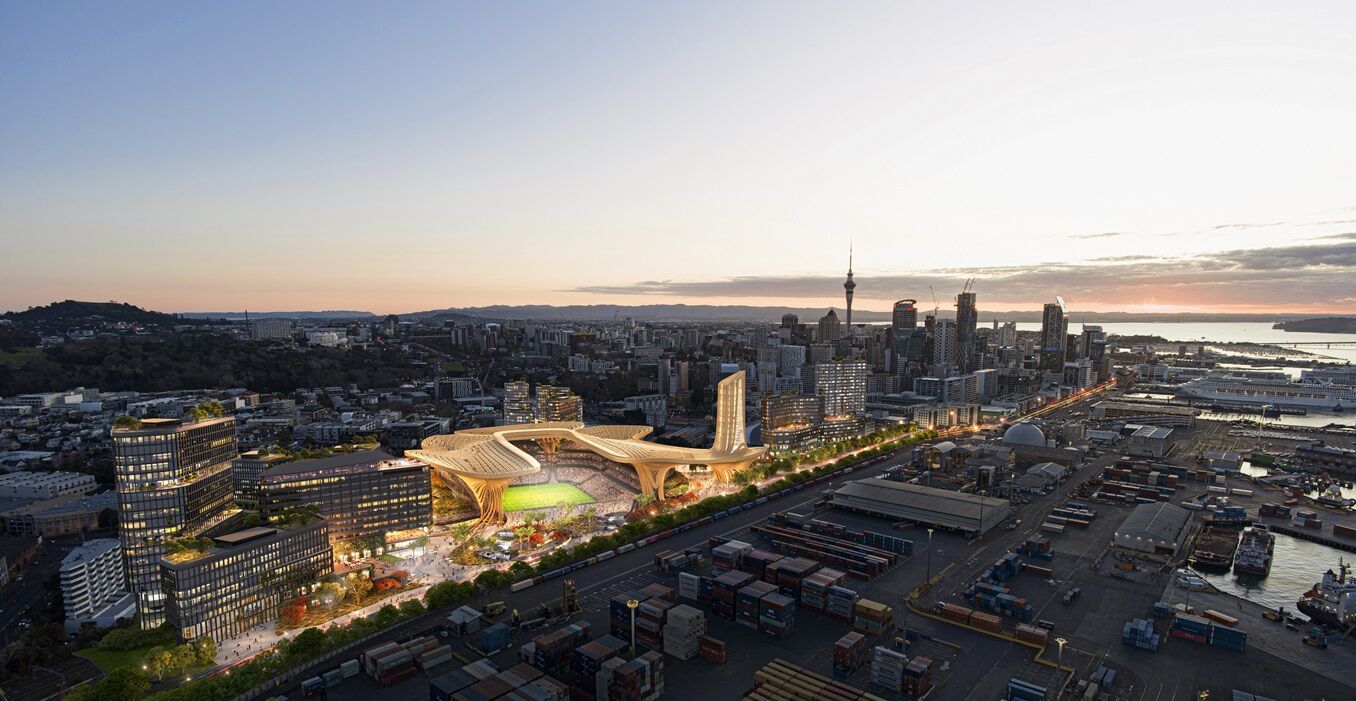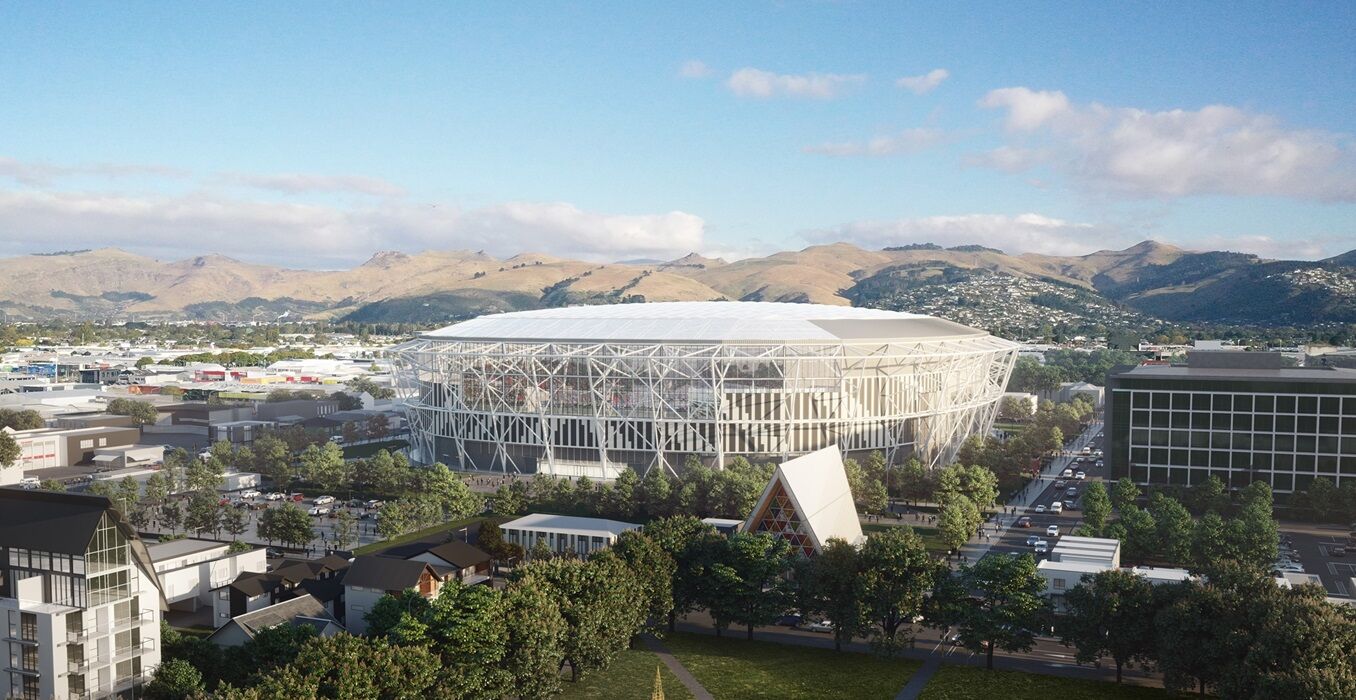Total Property -
Enter the arena

Artist's impression of Eden Park 2.1
Two bids remain in the battle for an Auckland-based national stadium. Total Property explores the two options and what they mean for Auckland’s commercial property landscape.
After years of planning, proposals and debate, the options for a main multi-use stadium for Auckland have been whittled down to two.
In May, Auckland Council announced it would progress two proposals for Auckland’s stadium to a feasibility stage, based on the recommendations of the council’s Stadium Venues Working Group, chaired by councillor Shane Henderson.
Those two projects are the Eden Park 2.1 proposal to revamp the current stadium in Sandringham, and a proposal by Te Tōangaroa Consortium to develop a new stadium at Quay Park, adjacent to Auckland’s CBD.
The two successful bidders have been invited to complete feasibility studies within a six-month timeframe and will be considered against Auckland’s stadium status quo.
Henderson says all submitters were asked to “present options for a national stadium that could be delivered at little to no cost to ratepayers, while providing a vision for a world-class, future-proof, multi-purpose main stadium that will deliver economic benefits for Aucklanders.”
Both organisations behind the two favoured stadium developments believe their proposals will offer significant benefits for the Auckland economy as well as opportunities for adjacent commercial property development.
Eden Park 2.1
The proposed revamp of Eden Park involves increasing the current national stadium’s capacity to 60,000, adding a retractable roof, building a new North Stand with retractable seating, upgrades to the East and West stands, and the addition of a pedestrian accessway across Sandringham Road to connect with Kingsland railway station.
A spokesperson for Eden Park says a thriving national stadium will always bring flow-on economic benefits not just to Auckland but the national economy, citing the impact of huge recent Eden Park events such as the Fifa Women’s World Cup which injected $87 million into Auckland region’s GDP, and major musical acts like Pink who boosted Auckland’s accommodation occupancy to 97 percent and Six60 who added an estimated $5.03 million to the national GDP.
“An enhanced stadium will attract a range of new events. The addition of a roof will provide surety to hirers, enabling content that may not be possible with the status quo, such as a UFC Fight Night or an esports tournament,” Eden Park says. “Any increase in content will provide a further boost to the economy.”
Building on existing transport links and neighbourhood relationships will also be key to creating a revamped stadium that benefits users as well as the wider community, Eden Park says. “Auckland’s City Rail Link will be operating in 2026, making Eden Park one of the best-located stadiums in the world.”
The City Rail Link will enable 50,000 people to be dispersed from Kingsland Station in 30 minutes, getting them to the CBD in nine minutes and to the Auckland waterfront in 12 minutes.
Part of the Eden Park 2.1 proposal is to work closely with local commercial enterprises to ensure the area around the stadium thrives, building on the existing precinct to further improve fan experience.
“Our focus is on continuous improvement of the stadium and surrounding precinct. This attraction and the provision of surrounding infrastructure, which includes established hospitality, retail and commercial businesses, delivers additional value and benefit to the local and wider economy,” Eden Park says.
To that end, Eden Park is a part of both the Fringe District Strategic Plan for Kingsland and Morningside, as well as the Dominion Road Business Association. Eden Park says statistics from consumer spending analysts Marketview over recent years indicate large events at Eden Park have a positive impact of more than $500,000 per event to Dominion Road businesses.
“We actively work to improve infrastructure and create opportunities for these businesses to thrive. The resources are already in place, and our opportunity remains to continue to strengthen and expand on them.”

Artist's impression of Te Tōangaroa
Te Tōangaroa/Quay Park
The proposal for the Te Tōangaroa development at Quay Park includes a 50,000-seat U-shaped stadium with a retractable roof, as well as hotels, bars, retail and commercial spaces, as well as apartments, education and health facilities. The proposed stadium precinct would be located on 15ha of Ngāti Whātua Ōrākei land, in the old Auckland Railways yard at Quay Park, near the existing Spark Arena.
The stadium design and facilities will transform the fan experience for Kiwi fans and visitors alike, bringing them close to the action while providing the amenities, comfort and protection from the elements that fans now expect.
The proposal has been put together by a consortium led by Jim Doyle and Paul Nisbet of Cenfield MXD involving world-leading international and local partners. Nisbet says stadium developments provide extensive economic and commercial benefits that impact cities and countries, attracting tourists, boosting hospitality, transportation, and retail sectors, while placing cities on the global map.
Commercial implications were a major factor in the design of the proposed Te Tōangaroa stadium, Nisbet says.
“The new stadium’s long-term viability is anchored in its integration into the new, vibrant 24/7 mixed-use urban neighbourhood. The development is expected to significantly stimulate the local economy, with an estimated annual economic impact of $653m and the creation of 7,515 jobs.”
Nisbet believes Quay Park’s location will be key to its success. “It’s well-connected to major transport hubs and routes, ensuring ease of access and travel to and from the stadium and surrounding areas.
“Planned infrastructure improvements will contribute to sustainable commercial growth, urban revitalisation and sustainability, making it an even more appealing place for people to visit, live, and work. This development exemplifies how a stadium can serve as a catalyst for broader economic and social development.”
The Quay Park brownfields site is primed for redevelopment, Nisbet says and the stadium and precinct will transform the area into a bustling mixed-use neighbourhood and commercial hub.
“We envision a vibrant, 24/7 precinct economy around the stadium, featuring a mix of hotels, hospitality venues, residential units, retail and commercial spaces, cultural and recreational facilities.
“Opportunities include sport-themed attractions that add to the stadium precinct such as museums, merchandise outlets and themed hotels. These and other, complementary developments will cater to a diverse population, foster a sense of community, and ensure continuous activity in downtown Auckland,” Nisbet says.

Artist's impression of One New Zealand Stadium in Christchurch
Great southern plans
Canterbury sports and entertainment fans are eagerly awaiting the completion of One New Zealand Stadium, under construction in Christchurch.
The project is now past the halfway mark with roof installation underway and the stadium on track for completion in April 2026.
One New Zealand Stadium will be managed and operated by council-controlled entity Venues Ōtautahi. CEO Caroline Harvie-Teare says the success of One New Zealand Stadium is important for the pride and whanaungatanga of the Christchurch community, without a stadium since the 2011 earthquake, but also for the significant economic benefits the venue will deliver.
“One New Zealand Stadium will underpin additional investment and economic growth to the region, will promote the region as an attractive place to work, study, live and visit, and will accelerate levels of investment in the central city,” Harvie-Teare says. “Along with hospitality and retail already in the vicinity of the stadium, we expect to see additional commercial investment in this part of the city that will leverage the significant visitation to the stadium. This will likely include accommodation, hospitality, retail and so on.”
The stadium project includes two retail tenancies which will be in-market in the near future, with Venues Ōtautahi seeking tenants that will make good use of the space to activate the venue both on and outside of event days to drive visitation and “breathe life into the precinct as a whole.”
“In time, the wider One New Zealand Stadium precinct will be developed as an entertainment hub as opportunities arise,” Harvie-Teare says.
“One New Zealand Stadium will provide much-needed activation in this part of the city and will not only create a more desirable and safer area, it will provide a wonderful platform to build increased levels of retail and hospitality in the area and a walkable pathway to and from the central city to the west of the stadium.”
Once complete the stadium is expected to attract around 500,000 guests and more than 200 events annually, drawing about 100,000 visitors to Christchurch with an estimated annual return to the local economy of $28 million from visitation alone.